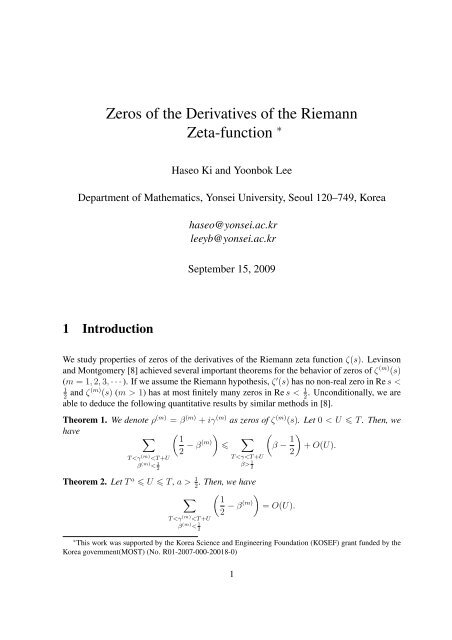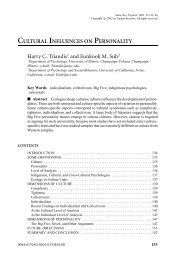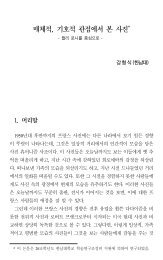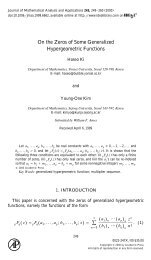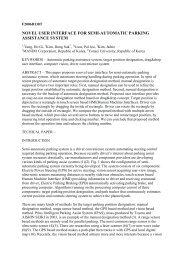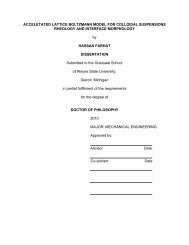Zeros of the Derivatives of the Riemann Zeta-function ∗
Zeros of the Derivatives of the Riemann Zeta-function ∗
Zeros of the Derivatives of the Riemann Zeta-function ∗
Create successful ePaper yourself
Turn your PDF publications into a flip-book with our unique Google optimized e-Paper software.
<strong>Zeros</strong> <strong>of</strong> <strong>the</strong> <strong>Derivatives</strong> <strong>of</strong> <strong>the</strong> <strong>Riemann</strong><br />
<strong>Zeta</strong>-<strong>function</strong> <strong>∗</strong><br />
Haseo Ki and Yoonbok Lee<br />
Department <strong>of</strong> Ma<strong>the</strong>matics, Yonsei University, Seoul 120–749, Korea<br />
1 Introduction<br />
haseo@yonsei.ac.kr<br />
leeyb@yonsei.ac.kr<br />
September 15, 2009<br />
We study properties <strong>of</strong> zeros <strong>of</strong> <strong>the</strong> derivatives <strong>of</strong> <strong>the</strong> <strong>Riemann</strong> zeta <strong>function</strong> ζ(s). Levinson<br />
and Montgomery [8] achieved several important <strong>the</strong>orems for <strong>the</strong> behavior <strong>of</strong> zeros <strong>of</strong> ζ (m) (s)<br />
(m = 1, 2, 3, · · · ). If we assume <strong>the</strong> <strong>Riemann</strong> hypo<strong>the</strong>sis, ζ ′ (s) has no non-real zero in Re s <<br />
1<br />
2 and ζ(m) (s) (m > 1) has at most finitely many zeros in Re s < 1.<br />
Unconditionally, we are<br />
2<br />
able to deduce <strong>the</strong> following quantitative results by similar methods in [8].<br />
Theorem 1. We denote ρ (m) = β (m) + iγ (m) as zeros <strong>of</strong> ζ (m) (s). Let 0 < U � T . Then, we<br />
have<br />
�<br />
� �<br />
1<br />
− β(m) �<br />
2 �<br />
�<br />
β − 1<br />
�<br />
+ O(U).<br />
2<br />
T
Theorem 3. For T a � U � T , a > 1,<br />
we have<br />
2<br />
2π<br />
�<br />
�<br />
β (m) − 1<br />
�<br />
= mU log log T + O(U).<br />
2<br />
T 0. Then we have<br />
� T log T<br />
1 � µm<br />
2π (1 + om(1)) (T → ∞),<br />
β (m) > 1<br />
2<br />
0 0.70.<br />
We note that this improves D. W. Farmer’s result κd � 0.63952 in [5].<br />
2
2 Lemmas<br />
We start with <strong>the</strong> following.<br />
Lemma 1. Let m = 1, 2, 3, . . ., χ(s) = 2sπs−1 sin πsΓ(1<br />
− s) and s = σ + it (σ, t ∈ R).<br />
2<br />
Then, we have<br />
χ (m)<br />
χ (s) = (− log |t|)m + O(log m−1 |t|)<br />
for |t| � t0 on any fixed vertical strip a � σ � b.<br />
Pro<strong>of</strong> <strong>of</strong> Lemma 1. From <strong>the</strong> Sterling formula, we have<br />
Γ ′<br />
(s) = log |t| + O(1);<br />
Γ<br />
dm dsm � ′ Γ<br />
Γ (s)<br />
�<br />
= O(t −m ) (m = 1, 2, 3, . . .).<br />
Thus we have<br />
χ ′<br />
χ<br />
(s) = −Γ′<br />
Γ<br />
πs sin 2<br />
(1 − s) + log 2π +<br />
cos πs<br />
2<br />
Suppose Lemma 1 is true for m � k. Then, we have<br />
χ (k+1) � (k) χ<br />
(s) =<br />
χ χ (s)<br />
�′<br />
+ χ(k)<br />
χ (s)χ′<br />
χ (s)<br />
= − log |t| + O(1).<br />
=O(log k |t|) + ((− log |t|) k + O(log k−1 |t|))(− log |t| + O(1))<br />
=(− log |t|) k+1 + O(log k |t|).<br />
By induction, we have proved <strong>the</strong> lemma.<br />
Lemma 2. Fix a nonnegative integer m. There is t1 > 0 such that χ (m) (s) has no zero or pole<br />
in |Im s| � t1, a � Re s � b.<br />
Pro<strong>of</strong> <strong>of</strong> Lemma 2. By <strong>the</strong> definition <strong>of</strong> χ(s) = 2sπs−1 sin πsΓ(1<br />
− s), we know that χ(s)<br />
2<br />
is meromorphic on <strong>the</strong> whole complex plane with poles at s = 1, 3, 5, 7, · · · , and zeros at<br />
s = 0, −2, −4, · · · . Thus, <strong>the</strong> Lemma 2 is true for m = 0. For <strong>the</strong> case m > 0, we use <strong>the</strong><br />
Lemma 1<br />
χ (m) (s) = χ(s) χ(m)<br />
χ (s) = χ(s)(− logm |t|) � 1 + O � log −1 |t| ��<br />
for |Im s| = |t| � t0. Thus, we prove <strong>the</strong> lemma.<br />
Lemma 3. Let −2 � aj � 2, bj, cj � 0, 0 < p < 1. Then, we have<br />
� 2 �<br />
�<br />
�<br />
�<br />
cj �<br />
�<br />
�<br />
x − aj + ibj<br />
p<br />
dx � 8<br />
�<br />
�<br />
� �<br />
�<br />
� cj�<br />
1 − p<br />
p<br />
.<br />
−2<br />
For Lemma 3, see [8, Lemma 4.1] or [6, Chap. 4].<br />
j<br />
j<br />
3
3 Pro<strong>of</strong>s <strong>of</strong> Theorems 1, 2, and 3<br />
Pro<strong>of</strong> <strong>of</strong> Theorem 1. We begin with <strong>the</strong> <strong>function</strong>al equation <strong>of</strong> <strong>the</strong> <strong>Riemann</strong> zeta <strong>function</strong><br />
ζ(1 − s) = χ(1 − s)ζ(s). By differentiating m times, we have<br />
Let Jm(s) be<br />
ζ (m) (1 − s) = χ (m) (1 − s)ζ(s) +<br />
Jm(s) = ζ(s) +<br />
m−1 �<br />
j=0<br />
m−1 �<br />
j=0<br />
� �<br />
m<br />
(−1)<br />
j<br />
m−j χ (j) (1 − s)ζ (m−j) (s).<br />
� �<br />
m m−j χ(j)<br />
(−1)<br />
j χ (m) (1 − s)ζ(m−j) (s). (3.1)<br />
We know that <strong>the</strong>re is Am > 1<br />
2 such that ζ(m) (s) has no zero on Re s � Am. Consider <strong>the</strong><br />
rectangle with vertices 1<br />
1<br />
+ i(T + U), 2 2 + iT , Am + iT , Am + i(T + U). Since ζ (m) (1 −<br />
s) = χ (m) (1 − s)Jm(s), all <strong>the</strong> zeros <strong>of</strong> Jm(s) in <strong>the</strong> rectangle are <strong>the</strong> same as <strong>the</strong> zeros <strong>of</strong><br />
ζ (m) (1 − s), and no poles <strong>the</strong>re by Lemma 2. Now, we can apply <strong>the</strong> Littlewood Lemma [10,<br />
Chap. 9.9] to get<br />
� T +U<br />
1<br />
2π T<br />
�<br />
�<br />
log �<br />
�<br />
Jm( 1<br />
2<br />
ζ( 1<br />
2<br />
�<br />
+ it) �<br />
�<br />
+ it) � dt =<br />
�<br />
T
Pro<strong>of</strong> <strong>of</strong> Claim. We recall that in [1], <strong>the</strong> number <strong>of</strong> zeros <strong>of</strong> ζ (k) (s) with 0 < γ (k) < T is<br />
T T<br />
log<br />
2π 4πe + Ok(log T ). (3.4)<br />
Let n be a large positive integer. For |t − n| � 1, 0 < σ < 1, k = 0, 1, 2, · · · , we have<br />
Then, by this, (3.4) and Lemma 3, we have<br />
� n+ 1<br />
2<br />
n− 1<br />
2<br />
�<br />
�<br />
�<br />
�<br />
ζ (k+1)<br />
ζ (k)<br />
From this, we have<br />
�<br />
1<br />
+ it<br />
2<br />
ζ (k+1) �<br />
(s) =<br />
ζ (k)<br />
|γ (k) 1<br />
+ O(log n).<br />
s − ρ (k)<br />
−n|
4 Pro<strong>of</strong>s <strong>of</strong> Theorems 4 and 5<br />
Pro<strong>of</strong> <strong>of</strong> Theorem 4. Apply <strong>the</strong> Littlewood Lemma to deduce<br />
� � T<br />
1 �<br />
log �<br />
2π �<br />
2<br />
JkB<br />
� ��<br />
1 R ���<br />
− + it dt =<br />
2 L �<br />
β (k) � 1<br />
2<br />
0
where <strong>the</strong> infimum takes over all polynomials P satisfying P (0) = 0, P (1) = 1. Since we are<br />
taking infimum over certain polynomial, it is equivalent to take any continuously differentiable<br />
sinh λx<br />
<strong>function</strong> with P (0) = 0, P (1) = 1. Thus, let P (x) = sinh λ . Then we have � 1<br />
0 P (x)2dx =<br />
� �<br />
1<br />
−2λ 1 + O λe 2λ<br />
�� , and � 1<br />
0 P ′ (x) 2dx = λ<br />
� �<br />
−2λ 1 + O λe 2<br />
�� . Thus, we have<br />
By taking<br />
inf<br />
P c(P, Qk, R) �1 +<br />
� 1<br />
e<br />
0<br />
2Ry Q(y)(Q ′ (y) + RQ(y))dy<br />
+ λ � � −2λ<br />
1 + O λe<br />
2θ<br />
�� � 1<br />
0<br />
+ θ � � −2λ<br />
1 + O λe<br />
2λ<br />
�� � 1<br />
�<br />
�<br />
�<br />
λ = θ�<br />
0<br />
e 2Ry Q(y) 2 dy<br />
� 1<br />
0 e2Ry (Q ′ (y) + RQ(y)) 2dy � 1<br />
0 e2RyQ(y) 2 ,<br />
dy<br />
e 2Ry (Q ′ (y) + RQ(y)) 2 dy.<br />
we get <strong>the</strong> minimal value <strong>of</strong> <strong>the</strong> right hand side in <strong>the</strong> previous inequality. Since<br />
� 1<br />
0<br />
e 2Ry Qk(y) 2 dy = 1 � � −1<br />
1 + O k<br />
2k<br />
�� ,<br />
� 1<br />
we have λ = kθ (1 + O (k −1 )), and<br />
0<br />
� 1<br />
e 2Ry Q ′ k(y) 2 dy = k � � −1<br />
1 + O k<br />
2<br />
�� ,<br />
inf<br />
P c(P, Qk, R) � 2 + O � k −1�<br />
0<br />
e 2Ry Q ′ k(y)Qk(y)dy = 1 � � −1<br />
1 + O k<br />
2<br />
�� ,<br />
as k → ∞. By this toge<strong>the</strong>r with (4.3) and (3.4), we conclude that for any fixed R > 0<br />
where µk = 1 −<br />
log 2<br />
2R<br />
�<br />
β (k) > 1<br />
2<br />
0
with <strong>the</strong> mollifier B(s) introduced in Theorem A. For <strong>the</strong> error term O(T/L), we need some<br />
condition <strong>of</strong> gj that will be discussed at <strong>the</strong> end <strong>of</strong> <strong>the</strong> pro<strong>of</strong>. We note that simple zeros <strong>of</strong> ξ(s)<br />
are not zeros <strong>of</strong> f(s), besides multiple zeros <strong>of</strong> ξ(s) are zeros whose multiplicities decrease<br />
by one. From symmetry <strong>of</strong> zeros <strong>of</strong> ξ(s) to 1/2, <strong>the</strong> left hand side <strong>of</strong> (4.4) is not less than<br />
R<br />
L (N(T ) − Nd(T )). By Jensen’s inequality, we can deduce that<br />
or<br />
N(T ) − Nd(T ) �<br />
T L<br />
4πR log<br />
�<br />
1<br />
T<br />
� T<br />
κd � 1 − 1<br />
2R log<br />
�<br />
1<br />
lim sup<br />
T →∞ T<br />
2<br />
�<br />
�<br />
�<br />
�fB � T<br />
2<br />
� �� �<br />
2<br />
1 R ���<br />
− + it dt<br />
2 L<br />
�<br />
�<br />
�<br />
�fB � �� �<br />
2<br />
1 R ���<br />
− + it dt .<br />
2 L<br />
+ O(T )<br />
All we need is to get an asymptotic formula for <strong>the</strong> mean square <strong>of</strong> fB. We have<br />
f(s) = (g + g0)ζ(s) + g1<br />
� ′ H<br />
L<br />
H (s)ζ(s) + ζ′ �<br />
(s) =<br />
� � s � �<br />
log 2π 1 d �1 � −1<br />
Q1 + ζ(s) + O |t|<br />
2L L ds<br />
�� ,<br />
where Q1(x) = g + g0 + g1x. Using <strong>the</strong> last two equations, integration by parts leads us to<br />
κd � 1 − 1<br />
2R log<br />
� � � T � �� �<br />
2<br />
1 �<br />
�<br />
1 R ���<br />
T �V B − + it dt ,<br />
2 L<br />
lim sup<br />
T →∞<br />
where V (s) = Q � − 1<br />
� �<br />
d<br />
1<br />
ζ(s), and Q(x) = Q1<br />
L ds<br />
2 − x� = g + g0 + 1<br />
2g1 − g1x. When<br />
we applied <strong>the</strong> Littlewood lemma in (4.4), we needed <strong>the</strong> condition Q(0) = 1. This yields<br />
Q(x) = 1 − g1x. In [2, p.10], Conrey made an optimal choice <strong>of</strong> this case. If we select g1 =<br />
1.02, R = 1.2, θ = 4<br />
7<br />
References<br />
2<br />
, we have log c<br />
R = 0.598.... Therefore, we conclude that κd > 0.70.<br />
[1] B. C. Berndt, The number <strong>of</strong> zeros for ζ (k) (s), J. London Math. Soc.(2) 2 (1970), 577–<br />
580<br />
[2] J. B. Conrey, More than two fifths <strong>of</strong> <strong>the</strong> zeros <strong>of</strong> <strong>the</strong> <strong>Riemann</strong> zeta <strong>function</strong> are on <strong>the</strong><br />
critical line, J. reine angew. Math. 399 (1989), 1–26<br />
[3] J. B. Conrey, A. Ghosh, and S. M. Gonek, Simple zeros <strong>of</strong> <strong>the</strong> <strong>Riemann</strong> zeta-<strong>function</strong>,<br />
Proc. London Math. Soc. (3) 76 (1998), 497–522<br />
[4] J. M. Deshouillers and H. Iwaniec, Kloosterman sums and Fourier coefficients <strong>of</strong> cusp<br />
forms, Invent. Math. 70 (1982), 219–288<br />
8
[5] D. W. Farmer, Counting distinct zeros <strong>of</strong> <strong>the</strong> <strong>Riemann</strong>-zeta <strong>function</strong>, Electron. J. Combin.<br />
2 (1995), Research Paper 1, approx. 5 pp.<br />
[6] N. Levinson, Gap and Density Theorems, Amer. Math. Soc. Colloq. Publ. Vol. 26, 1940.<br />
[7] N. Levinson, More than One Third <strong>of</strong> <strong>Zeros</strong> <strong>of</strong> <strong>Riemann</strong>’s <strong>Zeta</strong>-Function are on σ = 1/2,<br />
Adv. Math. 13 (1974), 383–436<br />
[8] N. Levinson and H. L. Montgomery, <strong>Zeros</strong> <strong>of</strong> <strong>the</strong> derivatives <strong>of</strong> <strong>the</strong> <strong>Riemann</strong> zeta<strong>function</strong>,<br />
Acta Math. 133 (1974), 49–65<br />
[9] A. Selberg, On <strong>the</strong> zeros <strong>of</strong> <strong>Riemann</strong>’s zeta <strong>function</strong>. Skr. Norske Vid. Akad. Oslo,<br />
(1942) no. 10.<br />
[10] E. C. Titchmarsh, The Theory <strong>of</strong> <strong>the</strong> <strong>Riemann</strong> <strong>Zeta</strong>-<strong>function</strong>, 2nd ed., revised by D. R.<br />
Heath-Brown, Oxford University Press, Oxford, 1986<br />
9


